Transport in Portugal is diversified. Portugal has a 68,732 km (42,708 mi) network of roads, of which almost 3,000 km (1,864 mi) are part of a 44 motorways system. Brisa is the largest highway management concessionaire. With 89,015 km2, Continental Portugal has 4 international airports located near Lisbon, Porto, Faro and Beja. The national railway system service is provided by Comboios de Portugal. The major seaports are located in Leixões, Aveiro, Figueira da Foz, Lisbon, Setúbal, Sines and Faro.

Heritage streetcars or heritage trams are a part of the efforts to preserve rail transit heritage. In addition to preserving street-running rail vehicles, heritage streetcar operations can include upkeep of historic rail infrastructure. Working heritage streetcars are closely related to the growing global heritage railway movement and form a part of the living history of rail transport.

The Porto Metro is a light rail network in Porto, Portugal and a key part of the city's public transport system. Having a semi-metro alignment; it runs underground in central Porto and above ground into the city's suburbs while using low-floor tram vehicles. The first parts of the system have been in operation since 2002. It is a separate system to Porto's vintage trams.

The Santa Justa Lift, also called Carmo Lift, is an elevator, or lift, in the civil parish of Santa Justa, in the historic center of Lisbon, Portugal. Situated at the end of Rua de Santa Justa, it connects the lower streets of the Baixa with the higher Largo do Carmo.

CP — Comboios de Portugal, EPE is a state-owned company which operates passenger trains in Portugal. Prior to June 2009, CP stood for Caminhos de Ferro Portugueses although the company has been using its current designation as a brand name since 2004.
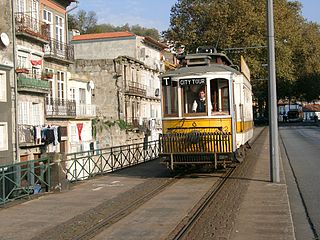
STCP is the public transport company that runs the bus and tram service in Greater Porto, Portugal. Created in 1946, it took over the Porto tram system from its privately owned predecessor and continues to operate it today, but the formerly large tram system now has only three lines, which are heritage tram lines, and the STCP network is now mostly bus service. STCP does not operate the city's light rail system, Porto Metro, but owns 25% of it. It is a public company controlled by a board responsible to the central government and had about 1,500 employees in 2009. STCP operates 83 bus routes – of which 11 are late-night-only routes – and the bus service covers 539 km of routes.
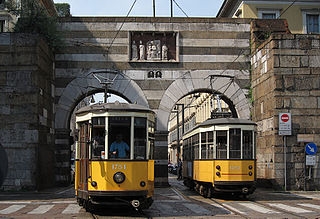
Europe has an extensive number of tramway networks. Some of these networks have been upgraded to light rail standards, called Stadtbahn in Germany, premetros in Belgium, sneltram in the Netherlands, trem ligeiro in Portugal and fast trams in some other countries.

Trams make an important contribution to public transport in the city of Zurich in Switzerland. The tram network serves most city neighbourhoods, and is the backbone of public transport within the city, albeit supplemented by the inner sections of the Zurich S-Bahn, along with urban trolleybus and bus routes, as well as two funicular railways, one rack railway and passenger boat lines on the river and on the lake. The trams and other city transport modes operate within a fare regime provided by the cantonal public transport authority Zürcher Verkehrsverbund (ZVV), which also covers regional rail and bus services.
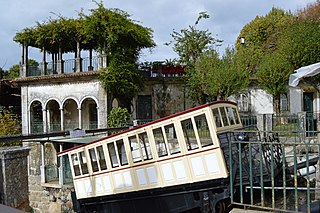
The Bom Jesus do Monte Funicular, is a Portuguese funicular transport in civil parish of Nogueiró e Tenões, in the municipality of Braga, in the district of the same name. Operated by the Irmandade de Bom Jesus do Monte the funicular connects the upper-town of Braga with the Shrine on which it gets its name, over a distance that parallels the Escadaria de Bom Jesus to the highest point at the statue of Saint Longinus.

The Alfa Pendular network, with top speeds of 220 km/h connects much of Portugal. In February 2009, the government of Portugal announced plans to build a high-speed rail line from Lisbon to Madrid; this plan was cancelled in March 2012 amidst a bailout programme of financial assistance to the Portuguese Republic. The project was valued at €7.8 billion and the government had claimed it would create 100,000 jobs. The line would link to Spain's Southwest Corridor.

The CP Urban Services network is the commuter train network of Metropolitan Lisbon and Metropolitan Porto, Portugal. It is a Comboios de Portugal company. It connects the city centers with the suburbs.

The Santa Teresa Tram, or Tramway, is a historic tram line in Rio de Janeiro, Brazil. It connects the city's centre with the primarily residential, inner-city neighbourhood of Santa Teresa, in the hills immediately southwest of downtown. It is mainly maintained as a tourist attraction and is nowadays considered a heritage tramway system, having been designated a national historic monument in 1985. The line has a very unusual gauge: 1,100 mm. The main line is 6.0 kilometres long.

The Dresden tramway network is a network of tramways forming the backbone of the public transport system in Dresden, a city in the federal state of Saxony, Germany. Opened in 1872, it has been operated since 1993 by Dresdner Verkehrsbetriebe (DVB), and is integrated in the Verkehrsverbund Oberelbe (VVO).

The tram system of Porto in Portugal is operated by the Sociedade de Transportes Colectivos do Porto (STCP) and currently has three regular tram routes with 30-minute headways. All are heritage tram routes, as they use vintage tramcars exclusively, and should not be confused with the modern Porto Metro light rail system.

The Lisbon tramway network is a system of trams that serves Lisbon, the capital city of Portugal. In operation since 1873, it presently comprises six lines. The system has a length of 31 km, and 63 trams in operation. The depot is located in Santo Amaro, in Alcântara.

Trams in Vienna are a vital part of the public transport system in Vienna, capital city of Austria. In operation since 1865, with the completion of a 2 km (1.2 mi) route to industrial estates near Simmering, it reached its maximum extent of 292 km (181.4 mi) in 1942. In February 2015, it was the fifth largest tram network in the world, at about 176.9 kilometres (109.9 mi) in total length and 1,071 stations.
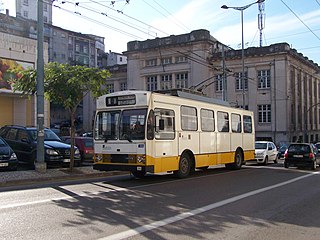
The Coimbra trolleybus system forms part of the public transport network in the city of Coimbra, Portugal. Opened in 1947, it supplemented, and then eventually replaced, the Coimbra tramway network. Service has been temporarily suspended since March 2021 and is not expected to resume before late 2024.

Portugal formerly had several hundred kilometres of narrow-gauge railways, but by 2010 only two lines were still in operation – the Vouga line and the Metro de Mirandela. The lines were operated by Comboios de Portugal and maintained by REFER.
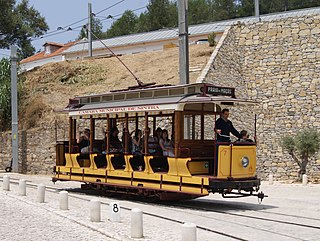
The Sintra tramway is a seasonal narrow gauge tourist tram line in Portugal. It links the town of Sintra with Praia das Maçãs, passing through Colares and close to the Praia Grande (Sintra). It has a length of some 11.5 kilometres (7.1 mi).
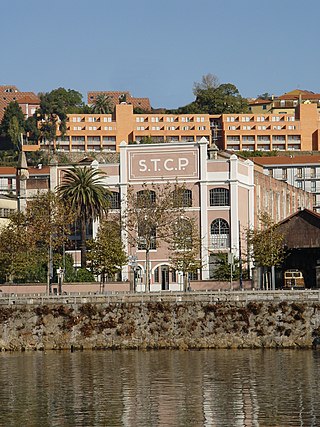
The Porto Tram Museum(Museu do Carro Eléctrico) is a museum operated by the Sociedade de Transportes Colectivos do Porto. It was inaugurated in 1992 and is installed in a former thermoelectric power station next to the River Douro in Massarelos, Porto, Portugal. It exhibits material related to the history of trams in Porto. The collection contains 16 electric cars, 5 trailers, and two maintenance vehicles as well as the former equipment of the power plant, which provided electricity for the tram lines.
























